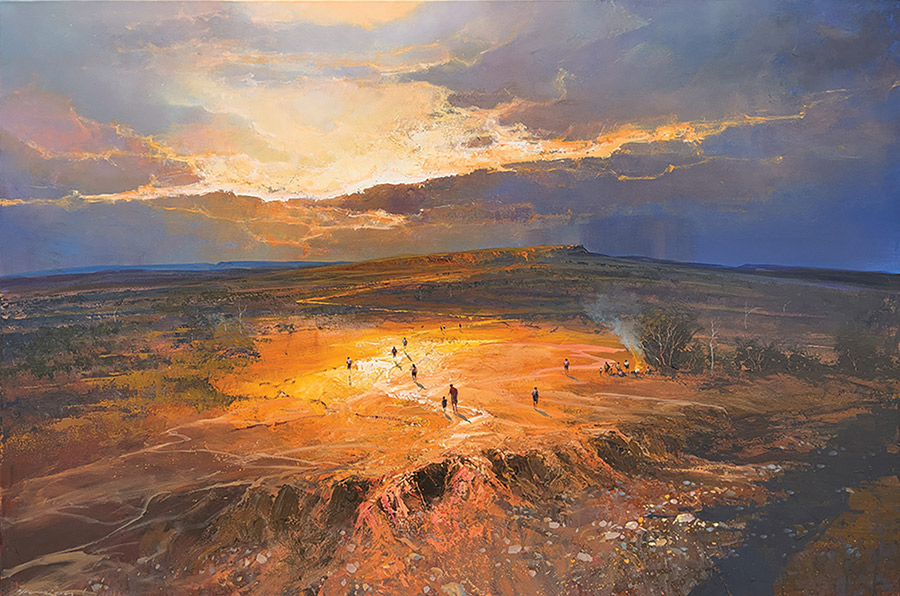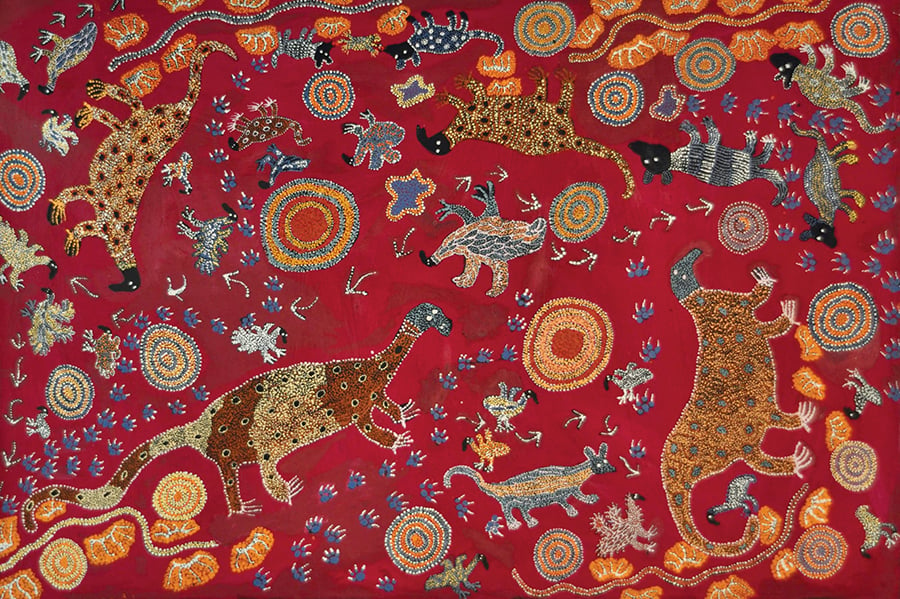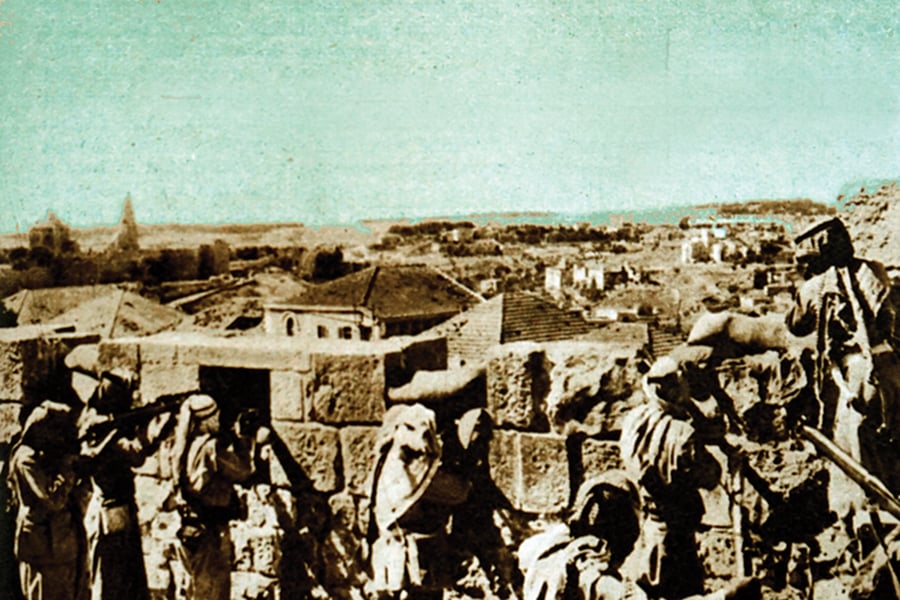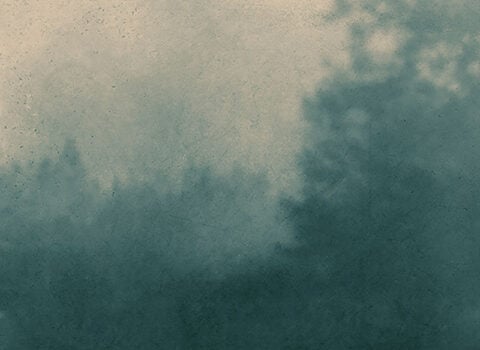
Outback Gathering, by Mel Brigg © The artist. Courtesy Wentworth Galleries, Sydney
Anyone who has seen the Australian outback knows that it defies description. The country’s pioneer history is relatively recent: it wasn’t until the second half of the nineteenth century that settlers from Europe joined deported convicts and their descendants in establishing towns and farms in the bush, often relying on the help of aboriginal peoples. The lore of this era, like narratives of the American West, is replete with stories of resourcefulness, brutality, and despair. In taking on the subject, Australia’s finest novelists—such as Patrick White and Peter Carey—have managed to articulate that which is almost ineffable.
They are now joined by Fiona McFarlane, whose engrossing second novel, The Sun Walks Down (Farrar, Straus and Giroux, $28), is set in the outback of the colony of South Australia in 1883. She has taken this stark historical canvas and populated it with unforgettably rendered characters and places. McFarlane’s version gives voice not only to men, both white and black, but also to a compelling array of women and girls, each with her own accomplishments, desires, and disappointments.
The novel unfolds over the course of a week, while strange and spectacular sunsets are being caused by the eruption of Krakatoa. On the first day, a six-year-old boy, Denny Wallace, wanders away from Undelcarra, his family’s farm, and is lost in a dust storm. His mother, Mary, who is deaf, doesn’t at first realize he is missing. His sisters are at a wedding, and his father is working the fields with his aboriginal farmhand.
By the time they return home and discover Denny’s absence, the day is ending. The search begins while “the sky is bright as a burning field.” McFarlane, deploying a divine perspective that slips, deftly fluid, into the minds of many of her characters, takes the long hunt for Denny as the novel’s frame, within which she conjures the complexities, idiosyncrasies, ambitions, struggles, and passions of a family and a community. Minna Baumann, the bride on this fateful day, is engulfed by desire for her husband, the constable Robert Manning, but has to reconcile herself to his absence while he looks for the lost boy. Fifteen-year-old Cissy, the most forceful of Denny’s sisters, roils with impatience at what she sees as the incompetence of the searchers, even as she seeks to bestow admiration on an adult worthy of it. The novel’s widowed matriarchs—Minna’s mother, Wilhelmina, swaddled in permanent mourning, and Joanna Axam, who owns the area’s most prosperous estate—enjoy dominating their children and servants. They surround themselves with objects, such as opal rings and silver bowls, that signify their status.
In precise, often glorious prose, the novel affords each character, including little Denny, a rich interiority, even as the landscape itself—a terrain layered with significance and myth for aboriginal peoples, while for Europeans “civilization” there appears thin—provokes awe. For Denny, at dusk,
the sun touched the red hill and the gods came creeping out of it—out of the sun. They parted the branches of the cypress tree and stepped with care over the rocks at the top of the hill. They ran like water down the hill, and their footsteps were like water around the corners of the house.
With this remarkable novel, McFarlane establishes her place in the firmament of Australian letters, reworking and expanding the imaginary of its early years.

Ngayuku Ngura—My Country, by Mary Katatjuku Pan © The artist. Courtesy Short St. Gallery, Broome, Australia
The land is also at the heart of the Palestinian writer and lawyer Raja Shehadeh’s memoir We Could Have Been Friends, My Father and I (Other Press, $22.99). His father, Aziz Shehadeh, whom Raja first wrote about in his 2002 book Strangers in the House: Coming of Age in Occupied Palestine, was a lawyer devoted to securing a Palestinian state. At the time of the earlier book, Raja’s views on tactics differed from his father’s, but over the years he has come to see things differently. When Aziz was assassinated outside his home in 1985 at the age of seventy-three, “he seemed very old” to his thirty-four-year-old son; he was “someone to whom [Raja] could not relate.” But he has since had a realization:
For years I lived as a son whose world was ruled by a fundamentally benevolent father with whom I was temporarily fighting. I was sure that we were moving, always moving, towards the ultimate happy family. . . . When he died before this could happen I had to wake up from my fantasy, had to face the godlessness of my world and the fact that it is time-bound. There was not enough time for the rebellion and the dream. The rebellion had consumed all the available time.
The grief that Raja feels at the loss of the dream is deep. But it has also been the impetus, now that Raja is approaching the age his father was when he died, to give voice to the older man’s accomplishments. He finally set about reading through his father’s files, discovering the “impressive clarity” of Aziz’s writings. He also learned that “his pioneering ideas were deliberately distorted by Israel, the Arab states and even some Palestinians.”
The Shehadeh family hails from Jaffa, where Aziz’s father was a judge. Aziz, his wife, and their two daughters left their home in the spring of 1948, during what would eventually be known as the Nakba, the catastrophe visited on Palestinians when the state of Israel was founded. They fled to Ramallah on the assumption they would only be gone for a few months, but they would never return. The violence at the end of the British Mandate in May made it clear that the Arab Legion—an army largely comprised of Bedouin soldiers marshaled by King Abdullah of Jordan, under the command of the British officer known as Glubb Pasha—would not defend the portion of land the United Nations had designated Palestinian territory. Aziz suspected that Jordan and Israel were colluding “to share between them the country that was Palestine and to prevent the refugees from returning to their former homes,” forcing them to settle in Jordan, an assessment whose accuracy would only become clear much later.
Aziz swiftly aligned himself against the Jordanian and Israeli authorities. He participated in the 1949 Lausanne conference to negotiate for the Palestinians’ right of return, aware that “without representation . . . we became vassals without rights, our future not in our own hands.” Despite his and others’ advocacy, the West Bank was annexed by Jordan on April 24, 1950. When King Abdullah was assassinated in Jerusalem a year later, Aziz defended three of the men accused of his murder in court: their acquittal earned Aziz the regime’s “unwavering hostility.” But it was “the case of the blocked accounts” that established Aziz’s reputation. When the state of Israel came into being, the Palestinian pound, then tied to the British pound, was “rendered unconvertible into any other currency,” meaning that the assets of thousands of Palestinian refugees were effectively frozen. Moreover, Israeli authorities subsequently informed Barclays Bank that the funds should be paid to the “Custodian of Absentee Property.” Israel then withdrew large sums, claiming they were needed “to finance an irrigation scheme.” It turned out that Israel was using the stolen money to water orchards it had taken from the Palestinians. Aziz, with his younger brother Fuad, successfully took on Barclays in the Jordanian courts. For three years, their client Bahia Barakat had been trying to access her money from exile in Cyprus. When the judge ordered the bank to pay her the whole balance plus 9 percent interest, a precedent was set, and Aziz and his brother were showered with new cases.
These victories were eclipsed by losses. In 1954, Aziz was jailed and then effectively exiled for eighteen months after running for a seat in Jordan’s parliament. He was imprisoned again in 1958 during a sweep of the country’s political dissidents. After the Six-Day War in 1967, Aziz was ready for peace, and proposed a “bold scheme of a Palestinian state next to Israel.” The two-state solution was revolutionary then, and since it involved acknowledging the Israeli state, “insults and accusations” were hurled.
At an age when Raja wanted to be accepted by his peers, Aziz’s apparently conciliatory politics seemed to his son remote, and even naïve: “Couldn’t my father see that the Palestinian people were engaged in armed struggle?” Only with bitter experience can Raja look back and see how his father’s frustrations mirror his own today. “I now fully appreciate that throughout his life my father sought the admirable objective of peace with our enemies and in that he never wavered,” he writes. And “now I realize, to my eternal regret, that the main reason why the love between us remained unacknowledged was me.” Raja’s memoir is a vital history of Aziz’s overlooked achievements; but it is also a son’s love letter to his father, an act of atonement.

The 1948 Arab-Israeli War © Universal History Archive/UIG/Bridgeman Images
Thomas Mann “is often thought to be cold, forbidding, humorless, a kind of impenetrable high-culture obelisk,” laments Damion Searls, whose excellent translation of Mann’s New Selected Stories (Liveright, $30) endeavors to accentuate an unexpected side of the German author. “The new translations in this book show that he was in fact as warm, hilarious, and heartbreaking a storyteller as anyone.” Certainly the opening story in the collection, “Chaotic World and Childhood Sorrow,” in its first new translation since the Thirties, is an insufficiently known gem. “In my view,” Searls writes in his introduction, it is “Mann’s best story. . . . I think it belongs up there with James Joyce’s ‘The Dead’ and anything you want to name by Gallant or Munro or Chekhov.” Like Joyce’s masterpiece, the story is about a party, and includes intense and vivid portraits not only of a patriarch, his wife, and their four children, but also of their servants and guests and, more broadly, their tumultuous historical moment, the hyperinflation crisis of 1921–23. It has been understood to depict four of Mann’s six children, two of whom eventually died by suicide.
“Chaotic World and Childhood Sorrow” was written in 1925, soon after The Magic Mountain was completed. The story opens jauntily, explaining that for lunch “there were only vegetables for the main course (baked Savoy cabbage),” followed by “a flummery made from one of the pudding powders you can buy now, tasting of almonds and soap.” It later becomes clear that this unappetizing meal is dictated by the “chaotic world” of the title. In spite of rampant inflation, food shortages, and the impossibility of repairing anything at all, the two older children of the Cornelius family are preparing for a party that afternoon. The antic eighteen-year-old Ingrid and seventeen-year-old Bert, known as the “Bigs,” hang with a bohemian crowd—their guests include a male actor in powder and rouge, a nature lover with floppy hair and a guitar, and a voluptuous blonde with “the shrill voice many stout women have.” The “Littles” are five and four: the girl, Lorrie, is doted on by her father, while her brother, Biter, a solid lad “like a young American athlete,” cleaves to their mother.
Professor Cornelius and his wife have managed, thus far, to hang on to their life as “villa-proletarians.” In addition to their saucy young butler Xaver (“revolutionary servant, likeable Bolshevist”), their employees include “the Hinterhöfer Ladies, two formerly middle-class sisters who now carry out the duties of cook and chambermaid,” and Nanny Anna, who “has recently had seventeen suppurated tooth-stumps removed.” Even as Mrs. Cornelius rushes to the shops “to transform a sum of money in hand into groceries, so as not to risk devaluation,” and serves their guests tea and “half-slices of bread spread with anchovy paste,” they all contrive to enjoy the gathering. All, that is, except little Lorrie, who falls in love with one of the guests, and whose obvious suffering pains her father—hence the “childhood sorrow.”
This story alone is worth the price of the volume. Searls offers fresh translations of other Mann classics, among them a delicious stand-alone extract from Buddenbrooks he has titled “A Day in the Life of Hanno Buddenbrook,” but which Mann referred to as “the schoolboy story”; for me it has something of the classroom scenes from Truffaut’s The 400 Blows about it. He also includes “Confessions of a Con Artist, by Felix Krull”—published on its own in 1922 before Mann decided to expand it into a multipart novel about Krull, which remained unfinished at his death—and the magisterial Death in Venice. The collection is rounded out by a shorter, slighter piece, “Louisey,” which is neither warm nor funny. It recounts the brutal mockery of a homely and doting husband by his attractive wife and her lover in a grotesque cabaret that involves blackface and cross-dressing. Though not Mann’s strongest story, it is unforgettable, and certainly belies any idea of the writer as a “high-culture obelisk.”

























































































